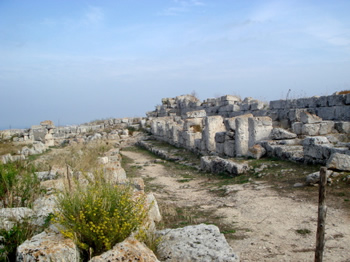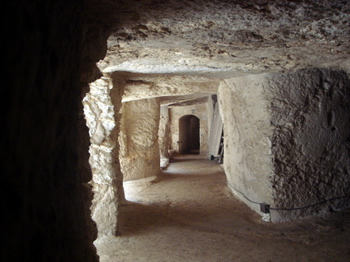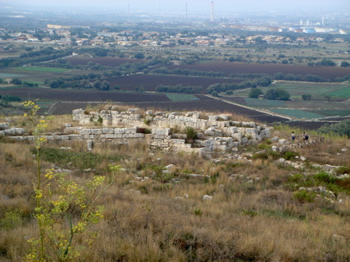 |
| The impressive carving through the rock done to create the "C" moat. In the background, the remains of a drawbridge. |
Euryalus Castle (the name comes from a
Greek word, eyryélos, which means "shaped like a nail")
of Syracuse is the largest castle dating back to Greek times that
survives until the present day and one of the most important Greek monuments
in Sicily.
Castles, as one knows, are created for
war, and as soon as the opportunity presents itself they are razed to the
ground either during or after a war.
 |
| The impressive carving through the rock done to create the "C" moat. In the background, the remains of a drawbridge. |
In spite of this, thanks to the fact that a large part of this building was dug directly into the rock, part of the structure of this particular castle survives (more unique than rare), impressive in size despite two and a half millennia having passed since its construction, and despite the hardships it endured (of its 8-10 original meters / 26-32 feet the walls that survive retain at their highest point 3 meters / 9 feet).
The castle was built by Dionysius the Elder in six years, between 402 and 397 B.C., a time during which Syracuse was preparing for the inevitable clash with the Carthaginians for control of eastern Sicily.
To strengthen the defense of the city Dionysius decided to fortify the Epipoli (upper city) which, during the Athenian attack and siege in 415-413 B.C., had proven to be a weak point in the defense system. The Athenians were, in fact, nearly successful in cutting Syracuse off from the mainland by building a wall that went from one side to the other ("from sea to sea") of the peninsula where the city stands.
In order to watch over this area, Dionysius built the castle, which, rising to a height of 120 meters / 393 feet above sea level, now offers tourists a vast panorama in all directions.
To complete the construction of the castle
and a good 27 kilometers / 16.8 miles of walls as soon as possible, 60,000
troops and 6,000 pairs of oxen were mobilized.
Dionysius’ choice proved appropriate,
and when the war broke out, Syracuse eventually prevailed.
 |
| The bases of the walls of the fortification, the principal structure of the Euryalus Castle. On the right, the thresholds of the soldiers quarters. |
The castle is divided into various parts, separated from each other by three moats dug into the rock (today only two are visible, the "B" and "C"). A dense network of tunnels dug into the rock allowed the soldiers to move very quickly from one part to the other without being seen or targeted by enemies.
From within the protection of the "B" moat a terrace rose where a battery of catapults, with which they could bomb the assailants from above, was stationed. (The mechanism was perfected by engineers from Syracuse: the great mathematician Archimedes himself did not refrain from creating new military machines during the Roman siege of 212 B.C.).
The principal structure (fortification), rose within the security of a further, deep moat (the "C", which is open to visitors) and five towers ("pentapylon": the foundations of which remain).
On either side, thresholds indicate the
space in which the soldiers' quarters stood, dating back to Byzantine
times.
Another threshold (also built in the Byzantine
era, when part of the castle was demolished in order to reconstruct the
building as a rectangular fortification) eventually leads to a long enclosure,
which narrows to form the tip of the imaginary "nail" from which the castle
derives its name.
The archaeological trail leads to this
point towards the entrance, passing through another side ditch, dug in
the rock, and some underground tunnels, to great effect.
 |
 |
| One of the many underground walkways that connects the various parts of the castle. | The panorama that one admires from Euryalus Castle. |
How to Reach Euryalus Castle from the
Algilà
Ortigia Charme Hotel.
The Euryalus Castle was constructed to
protect the extreme north of the ancient city of Syracuse, which was very
extensive. It is located, therefore, on the extreme point of the
triangle of Greek fortifications in Syracuse, outside the current city,
7 kilometers / 4.3 miles from the Island of Ortigia.
To reach it, therefore, it is necessary
to have a car at one’s disposal, or to call for a taxi from the reception
desk at a special rate.
Alternatively, you can take the (free) shuttle bus # 20 from nearby Piazza Archimede up to the bus station (near the train station) and then chose from circolare 25 or circolare 26 (weekdays) or line 11 (on holidays).
Visitor Information
Tickets can be purchased at the entrance
to the castle (€ 2, € 1 reduced).
The area is open daily from 9:00 a.m.
to 5:00 p.m. For information: tel. (++39) 0931 711773.
Although the height difference between
various parts of the building - which is for the most part flat - is minimal,
the path is rough in parts (owing to clay soil, rocks and outcrops of rock,
and a raised threshold between the fort and enclosure).
Thus, despite the absence of insurmountable
architectural barriers (however, the portion of the basement is accessible
only by a stairway!) the castle cannot be considered fully accessible for
people with walking difficulties.
Back to TOURISM IN SYRACUSE, SICILY